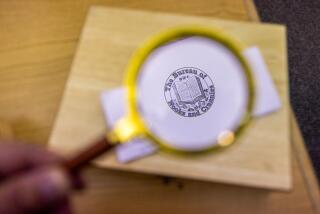One for the Books
Goofy can be grand, too. Stretched out along a strip of sagging bungalows and gleaming new billboards, the Robertson Branch Library is a cartoon-like replica of more lofty architectural visions. Yet, somehow, it works.
The little $3.3-million library is part of a long-running plan to revamp Los Angeles’ dilapidated library system: Of 26 library projects included in the plan (18 are now complete), 13 are new buildings. But the Robertson Branch Library, located at 9233 Airdrome St., is one of the few where cash-strapped city administrators risked a relatively high degree of architectural experimentation.
Designed by Santa Monica-based architect Steven Ehrlich, the building aspires to avant-garde status rather than the civic-minded grandeur of more traditional libraries. Ehrlich is the designer of the sleekly corporate 1992 Sony Music building on Colorado Avenue in Santa Monica and, more recently, DreamWorks’ SKG still unbuilt mock-Italian village in Glendale. That design--a theme-park-like studio complex that harks back to the studio days of Charlie Chaplin--disguises its nostalgic origins under a layer of high-tech materials.
But if the DreamWorks SKG plan is a blatant corporate fantasy, Robertson Branch Library has more lofty ambitions. The long, sleek building is sliced in two near one end by a towering lobby space that vaguely resembles a bulging ship’s hull. Cars stream in through a wide carport that leads to parking in back. Above, the library’s flat roof slopes upward to give the composition a dynamic look, while the blank, horizontal facade--clad in porcelain bathroom tile--has one single gaping porthole, like a cold blank eye surveying passersby.
Visitors enter by slipping along this main facade past a concrete bench and into the bowl-shaped atrium lobby. Once inside, the space is surprisingly cozy. A metal stair curves up to the library circulation desk on the second floor. Reading rooms on either side are cheerful and well-lit. A row of cylindrical skylights leads back to the children’s section, where the roof drops to fit the pint-sized scale of its occupants.
But the big gesture here is the atrium lobby. Clad in patinated copper, three stories tall, the atrium literally cleaves the building in two: Outside, it looms over the street like a ship’s prow. Inside, it defines the space. On the first floor, its bulging walls cut through the administrative offices and community room on both sides. Above, it divides the reading rooms and stacks, which must connect over the atrium via a bridge.
*
To add to the effect, the atrium’s orientation is slightly skewed. Rather than connect to the geometry of the street, its principal axis lines up with the downtown skyline. From the circulation desk at the top of the entry stair, visitors can look back across the gaping void of the atrium through a narrow vertical window at the mother branch in the far distance. The idea is to connect the activity in the local branch to a greater meaning, and to create visual tension between the shifting axes.
It is one of the cliches of contemporary architecture. At the 1889 Wexner Center for the Visual Arts in Columbus, Ohio, for example, Peter Eisenman--the self-proclaimed architectural gadfly--created “an architecture of dislocation” based on overlapping grids: Parts of the building lined up with the campus grid, others shifted 12 1/2 degrees to match the city’s street plan. (The rumor was that the axis that cut the building in two pointed in the direction of the architect’s girlfriend’s house.) At the Robertson library, these subliminal messages are boiled down to a parody.
But whimsy may be the point. Cast aside the intellectual pretense and the design echoes futuristic ‘50s L.A., not contemporary high-end academia. The building’s design--with its sloped roof and motel-like entry--evokes the low-brow glamour of Googie coffee shops rather than the machine-like fantasies of Albert Frey or John Lautner. Think amoeba-shaped pools, pink umbrellas, highway billboards, scraggy palms.
Like these images, it is the lightheartedness of the building that catches our attention. Materials collide bluntly; the structure is overblown. Perhaps most telling, the atrium’s copper skin has been carefully patinated to give it an even, artificial-looking aqua color, and to avoid the natural aging that would show the slow--and more elegant--wear of time. In cartoon-land, time stands still.
That’s not all bad. Others have gleefully popularized cutting-edge design--with splashy results. In the 1950s, Morris Lapidus’ curvaceous New York storefronts and angled, tile-clad hotels evoked a dynamic, progress-driven world swaddled in the safety of middlebrow values. Lapidus was a romantic dreamer, a skilled draftsman who created unrepentant fantasies. Ehrlich’s architecture is the product of a nostalgia for drive-by aesthetics.
For architecture’s avant-garde, nothing has been more frustrating than its inability to alter the everyday spaces we inhabit. Le Corbusier’s wonderfully imaginative housing schemes of the 1920s have little to do with the dreary housing projects that came to clutter our urban centers. Frank Lloyd Wright’s visions for bucolic garden cities came to naught. In Los Angeles, that gap between the world of the intelligentsia and the world of the developer has produced a range of architectural expression ranging from the truly great to the strangely idiosyncratic.
*
But not all architecture can have lasting historical importance--nor should it. Not all architects can achieve the compositional subtlety and the true invention that marks great work. Instead, it is the lesser talents that inevitably translate these visions for everyday consumption and shape our daily environment.
In Los Angeles, the language of the everyday is the language of the strip and the mini-mall. That is the language that Ehrlich unintentionally evokes. It may be goofy, but it is part of our legacy. And like Goofy, it has a certain charm.
More to Read
The biggest entertainment stories
Get our big stories about Hollywood, film, television, music, arts, culture and more right in your inbox as soon as they publish.
You may occasionally receive promotional content from the Los Angeles Times.










